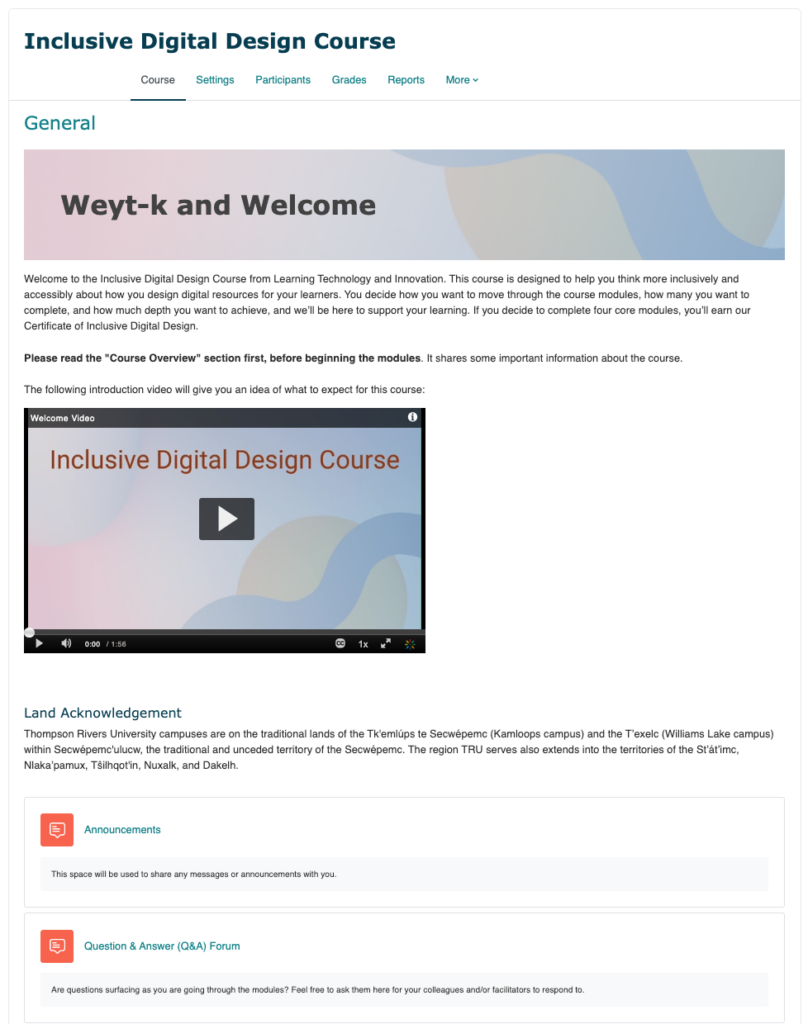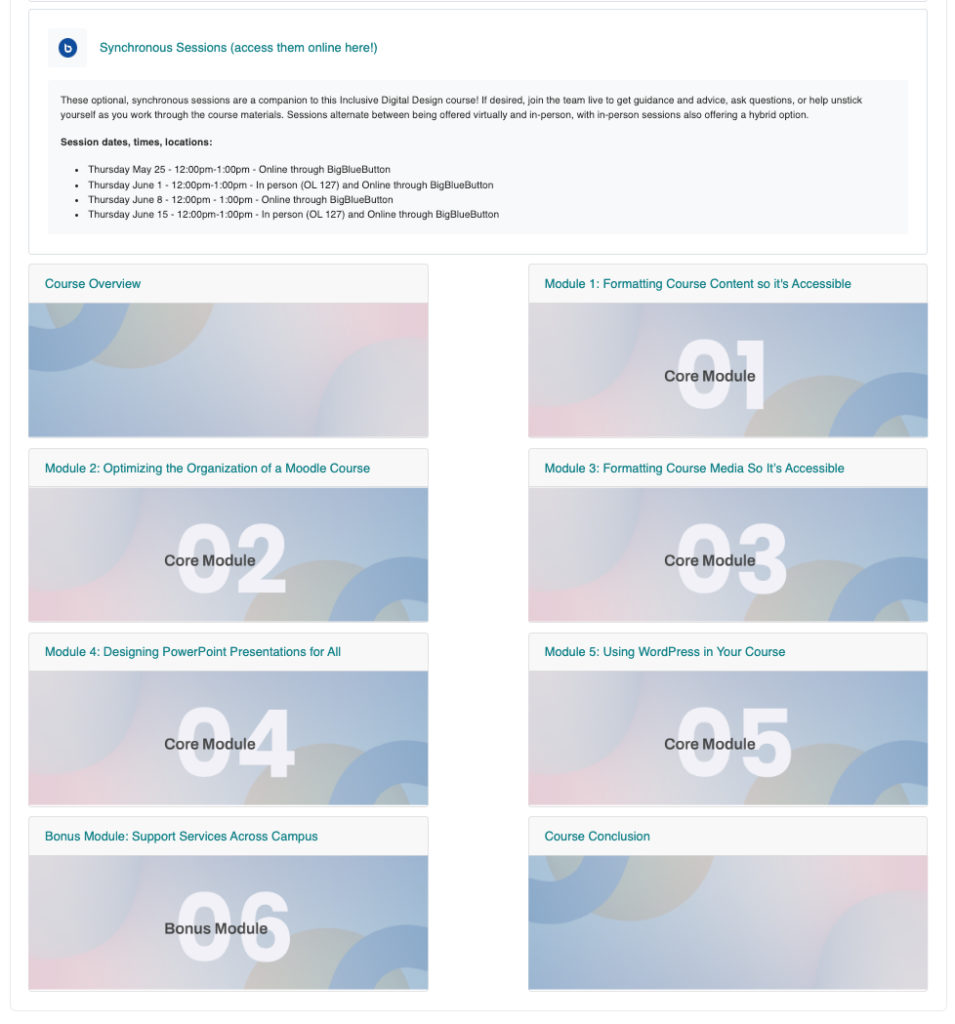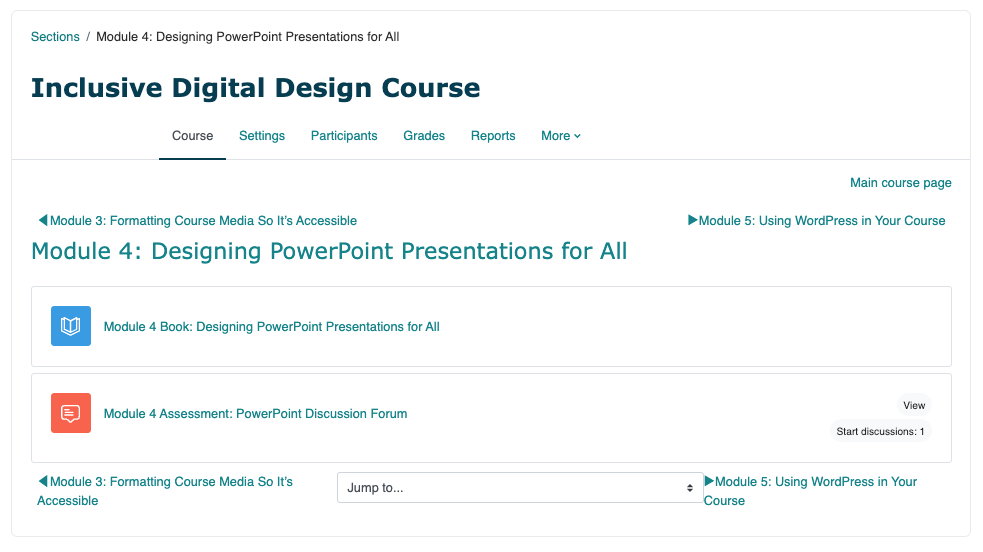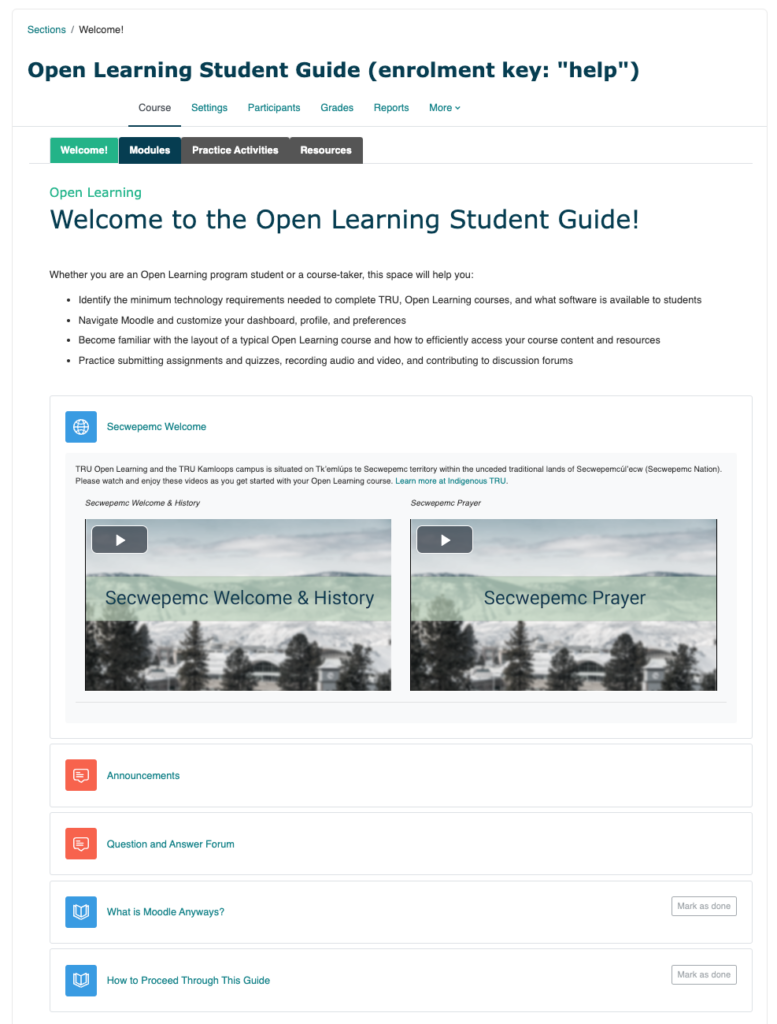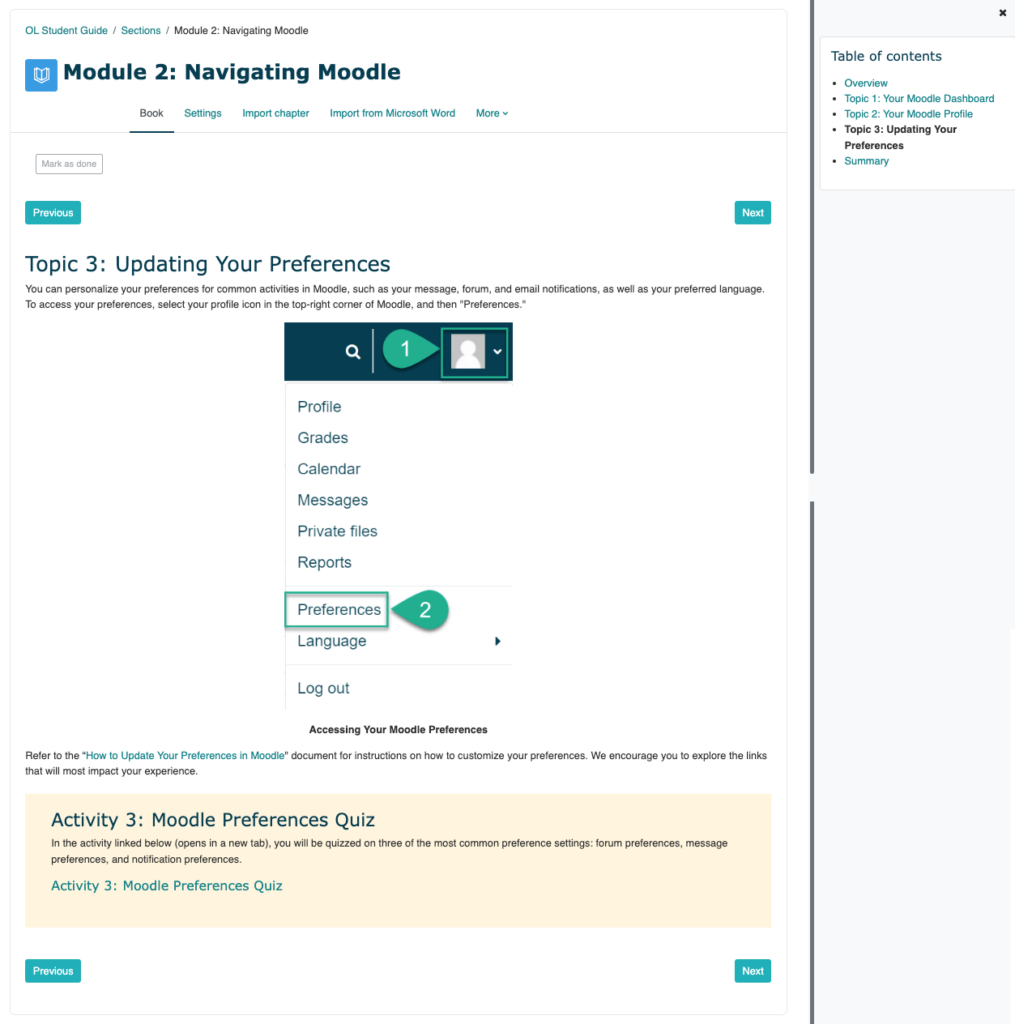Please use the tabs at the top of this page to navigate between projects.
Project 1: Inclusive Digital Design Course Development and Delivery
a) Having a background in instructional design, I led the LT&I team (Jamie Drozda, Brenna Clarke Gray, Brad Forsyth) through the program development process. Together, we turned the original vision of a “Multiple Modes of Access” offering into the “Inclusive Digital Design Course” for faculty and staff at TRU. This work was supported by graphic development from Nicole Singular (Graphic Designer, Open Learning) and introduction and promotional videos by Jon Fulton (Video Producer, Open Learning).
b) Through our day-to-day interactions with faculty, our team saw they were looking for support to make their classrooms more inclusive by better understanding learner needs. In response to this, our team developed a course with 6 modules that provides guidance around creating inclusive, accessible, and learner-centered course elements (course content, video, audio, PowerPoint slides) and learning platforms (Moodle, WordPress). Since LT&I noticed a trend of low enrolments for synchronous sessions, we decided an online asynchronous offering would provide greater flexibility and hopefully reach more people.
One challenge was deciding what platform to deliver this course out of. We wanted to make it as open as possible but didn’t have time to learn the entire LearnDash platform (a learning management system that runs off of WordPress). After considering our options, we decided to start small and offer the course for the first time through Moodle to just the TRU community. This felt more manageable and would allow us to gather feedback that could be integrated into the next offering for a wider audience.
c) The overall project management involved me setting meetings every 2 weeks, identifying and prioritizing agenda items each meeting, and reviewing the course as a whole at the end. Also, I created a schedule to help organize specific tasks that needed to be completed each month. I changed the colour of the table to grey when the tasks that month were completed to help us focus on the months to come.
The project development process for this course was a collaborative effort that involved 3 main components:
First, developing the Inclusive Digital Design Planning Map. This involved creating course learning outcomes and aligning the course with the provincial digital literacy competencies that are part of the B.C. Post-Secondary Digital Learning Strategy.
In this map, high-level planning maps were also created for each module and then used to guide the development of the specific module content in separate documents. Over time, the module planning evolved from Version 1 (the initial and broad brainstorming) to Version 2 (more specific and concise planning after discussions and collaboration). Please see the Module 1, Version 1 and 2 Comparison for an example.
Second, developing the Moodle course. This involved inputting the module content, enrolling participants, and designing the overall online learning experience. I designed the course landing page using graphics that Nicole Singular developed for our LT&I team. It features important course elements such as an introduction video, land acknowledgement, announcements board, link to synchronous sessions, and course modules. These elements help to welcome participants to the space, share necessary information, and provide avenues for support. To browse the Inclusive Digital Design Moodle Course, you may self-enrol into it using the enrolment key “inclusive” or you may view the screenshots below.
Third, marketing the course. This involved creating marketing messages for the LT&I workshops website, TRU connect, and an email to program Chairs.
d) I see this course as a way to increase campus capacity in developing learning experiences that consider inclusivity, accessibility, and learner-centeredness. This aligns with TRU values of inclusion, community-mindedness, and curiosity. Our ultimate goal is to create this as an open experience that reduces barriers to access which aligns with LT&I values. So, once we gather feedback from this offering, we will explore avenues for open access.
Also, the course exemplifies effective online course design practices such as consistent course and module structures and chunked module content within the books.
e) As of May 15, 2023, when the course opened, we had 62 participants registered. This number may increase as we will allow for continued enrollment until the course closes at the end of June. At that time, we will be able to see the depth to which participants engaged in the course and how many completed the modules to earn a certificate. We were pleased to see a high enrollment number and imagine it’s due to interest in the subject matter, offering the course asynchronously, and providing flexibility in terms of ways to participate.
f) As part of our support work with faculty members, the LT&I team encourages faculty to maximize accessibility and learner-centeredness in their courses. We modeled this in the course by integrating inclusive, accessible, and learner-centered features throughout to showcase how it can be built into learning. For example, we included assessments that offered choice, included multimedia elements for multiple ways to engage with content, and offered choice in modules to complete. Now, we have a resource that can support faculty with implementing these strategies in their own courses.
A lesson we learned was creating a bonus module, rather than it being one of the core modules. The original intent for the bonus module was to share support services across campus that faculty can connect students with. However, when developing it, it evolved into a more robust module. So, for future instances of this course, we would consider changing the “bonus optional module” into a core module option. This way, it would make the program less complicated and streamline certificate options.
g) The first instance of this course runs from May 15th-June 16th where we will gather feedback to learn about participant experiences. Then, our goal is to integrate that feedback and build this course on LearnDash after experimenting with the platform. LearnDash will give us the features we utilized in Moodle but in a platform that is open and accessible to people internal and external to TRU. Our intent is to run a second instance of this course through LearnDash in the 2023-2024 year that is open to people internal or external to TRU.
Screenshots
The following are screenshots of the course home page, module structure, and module content. Clicking the images will expand them and open them in a new tab.
Project 2: Open Learning Student Guide
a) Myself, Brad Forsyth (Learning Technologist, LT&I), and Rachel Cantin (Learning Strategist, Open Learning) created the “Open Learning Student Guide” Moodle course to help Open Learning (OL) students become familiarized with Moodle. I took the lead on determining a direction and structure for the course while Brad and Rachel focused on content development.
b) Oftentimes, students who enroll in OL courses haven’t participated in self-directed study or may have limited technical skills. A comprehensive, up-to-date resource to support students as they transition into OL’s self-directed, online environment didn’t exist (to our knowledge). To help fill this gap, we developed a course that features two pathways. Path 1 (Moodle Orientation) helps students learn about the technology needed for OL, how to navigate Moodle, how to navigate an OL course, and how to use Moodle tools (Quizzes, Assignments, Discussion Forums). Path 2 (Student Success) is under construction but will share guidance around common OL topics such as time management, communicating with your instructor, succeeding at academic reading and writing, writing final exams, academic integrity, and health and wellness.
c) For Path 1, I led the development of the OL Student Moodle Orientation Brainstorming resource to gather our high-level thoughts about this course. It began as a list of areas that would benefit OL students (original planning) which was then used to guide the development of a series of modules (final planning).
Once we had our final plan determined, we began developing the specific content in a secondary document. When the content was created, Brad imported it into Moodle and created the learning activities and assessments. The course was designed to mimic the look and feel of an Open Learning course to help students become familiar with that layout. Feedback from OL staff was provided and integrated such as changing the title from using the word “orientation” to “guide” and including the Secewpemc Welcome. For Path 2, we are currently drafting a brainstorming document and will resume development in Fall 2023. To browse the Open Learning Student Guide Moodle Course, you may self-enrol into it using the enrolment key “help” or you may view the screenshots below.
d) This self-directed learning opportunity mirrors the OL style of learning. This way, students become familiar with the environment, function, and style of learning they will be engaging in. Also, this course provides a space where students can explore Moodle tools and learn about material that directly relates to their OL experience.
e) The course became live May 1, 2023 and 514 students are currently enrolled in it. To further promote this course, Rachel showcases it during the orientation sessions she leads for new OL students. To get a sense of engagement so far, 102 students have completed the practice quiz, 142 students have completed the practice assignments, and 81 students have completed the practice discussion forum.
f) This resource is personalized to TRU and illustrates specific experiences OL students will encounter, which makes it much more relevant. This allows students to focus on the important information rather than weeding through irrelevant material. Also, from the support view, having a resource to be able to pull information from or point students to will save time and effort when answering student questions that come in through email/tickets. Hopefully, in time, the frequency of questions related to the subject matter of the course will be reduced now that the course is available. Even though the direct support I provide to OL students and faculty is limited, being a part of this project gave me valuable insight into the experience of OL students.
g) The course will continue to grow to include Path 2 (Student Success) when the material is developed. Then, this will be a comprehensive resource for OL students that can be accessed at any time during their studies.
Screenshots
The following are screenshots of the course landing page, module structure, and module content. Clicking the images will expand them and open them in a new tab.
Project 3: VISA 4990 WordPress Template
a) An instructor wanted her students to build an ePortfolio as part of VISA 4990. To support this, I customized an existing ePortfolio website template to better suit the needs of the assignment. Then, I visited the classroom to introduce students to TRUBOX (TRU’s locally-hosted instance of WordPress) and provided support as they built their ePortfolios.
b) Since VISA 4990 is a graduating seminar class, an ePortfolio is a very relevant assignment. It allows students to demonstrate their learning to their instructor while also providing a means to showcase their work to prospective employers after graduation. After showcasing a few template options, the instructor and I collaborated on customizing an existing portfolio template to better suit the expectations for the assignment. More specifically, I replaced irrelevant instructions with more suitable instructions, added social media icons, and adjusted the course menu headings in the customized ePortfolio template. Browse the websites linked above or view the home page screenshots below.
c) The process began with discussing the assignment goals with the instructor – the purpose of the website, what they want the website to look like, and showcasing some existing templates. Then, I customized one of LT&I’s existing portfolio templates to better suit the expectations for the assignment. Once the template was finalized, I visited the classroom and held a demonstration for students about what WordPress is, how it relates to their assignment, and some basic tips to get started. I created a lesson plan to keep my classroom visit focused and on topic (described further in the “Instruction” section). After the session, students would be able to clone the template and use it as a base to begin their website development work. As the project progressed and students began developing their websites, I supported them by answering questions through email, tickets, and virtual office hours.
d) This project serves as an example of how the LT&I team supports faculty members and their classes with website development projects. These kinds of projects are meaningful, relevant, build digital literacy skills, and support open pedagogy – all elements the LT&I team values.
e) While the original template has been used with other VISA classes in the past, this is the first use of the modified template for a faculty member and 9 students. I look forward to using it again in the future to enhance reach and see how it evolves in a different context. I also learned how to add this template to the Clone Zone area. This means the website template I modified is now an option for students to choose when going through the self-serve process of setting up a website for themselves. This means students beyond the VISA classroom can choose it, if they are interested.
f) This was the first time I led this style of project on my own. So, having a pool of ePortfolio templates to draw upon (that were built for previous projects) allowed me to choose one that was suitable for this project. Overall, this pool of templates saves the LT&I team time because modifying a template is significantly less work compared to building one from scratch. That being said, one day, I would still like to develop a template from scratch to continue adding to the existing pool, especially if it is for a unique assignment. This way, it would broaden the pool and not just increase the number of templates in an existing category such as ePortfolios.
For future sessions, I will use the lesson plan I developed and customize it as needed. Also, I think it would be a helpful resource for future Coordinators in this role as it was something I was looking for when I started.
Lastly, I encouraged a follow-up visit to the classroom so I could answer any questions or troubleshoot any problems. However, due to limited time in that course, it did not occur. I think this follow-up meeting would help the project come full circle and allow everyone to reflect on the progress made. So, I will try to plan a follow-up meeting at the start of the project rather than determine its necessity later in the project.
g) For future ePortfolio projects, I will showcase the template I modified as an example that can be used.
Screenshots
The following are screenshots of the course home pages for the original template and the customized template. Clicking the images will expand them and open them in a new tab.
